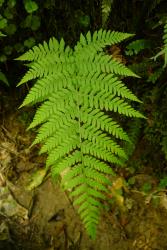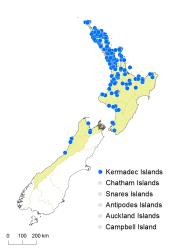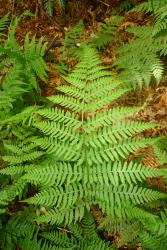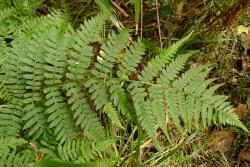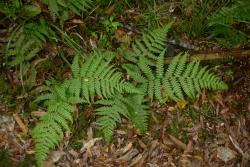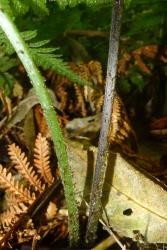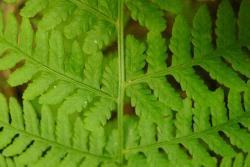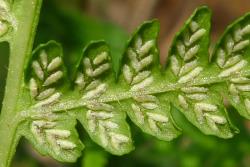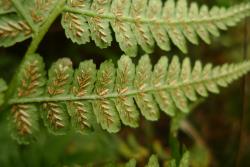- ≡ Diplazium congruum Brack., U.S. Expl. Exped., Filic. 16, 141, t. 18, f. 2 (1854)
- ≡ Athyrium congruum (Brack.) Copel., Univ. Calif. Publ. Bot. 14: 359 (1929)
- = Asplenium umbrosum var. tenuifolium Kirk, Trans. & Proc. New Zealand Inst. 23: 425 (1891)
- ≡ Deparia tenuifolia (Kirk) M.Kato, J. Fac. Sci. Univ. Tokyo, Sect. 3, Bot. 13: 407 (1984)
- = Asplenium umbrosum var. multifidum Dobbie, New Zealand Ferns ed. 3, 316, f. 104b (1931)
Rhizomes long-creeping, up to 260 mm long (in herbarium specimens), 2.5–7 mm in diameter, with stipes arising 5–40 mm apart; bearing scales. Rhizome scales ovate or narrowly ovate, 4–6 mm long, 0.8–2 mm wide, golden brown. Fronds 180–910 mm long. Stipes 35–480 mm, blackish-brown proximally, yellow-brown or rarely red-brown distally; bearing multicellular pale brown hairs up to 0.5 mm long, and narrowly ovate, pale to dark brown scales up to 9 mm long and 2.5 mm wide. Rachises yellow-brown or rarely red-brown, becoming green distally, winged distally, adaxially grooved, bearing multicellular hairs up to 0.5 mm long, and scales up to 1.5 mm long; hairs more abundant distally. Laminae 1-pinnate-pinnatifid to 1-pinnate-bipinnatifid, elliptic or ovate or narrowly ovate, tapering to a pinnatifid apex, 115–510 mm long, 40–270 mm wide, dark green adaxially, yellow-green abaxially, herbaceous or coriaceous, bearing multicellular colourless hairs to 1 mm long and linear pale brown scales to 1.5 mm long; hairs more abundant on adaxial surface. Primary pinnae in 7–15 pairs below pinnatifid apex, scarcely overlapping, winged throughout, narrowly elliptic or ovate; the longest at or below the middle of the lamina, 20–195 mm long, 10–75 mm wide, apices acuminate, deeply divided almost to the costae into secondary segments, short-stalked or rarely sessile. Secondary segments oblong; the longest at or below the middle of the primary pinna, 5–40 mm long, 3–10 mm wide, apices acute or obtuse, margins serrate to divided halfway to the midrib, or rarely ¾ to the midrib, bases adnate; the distal secondary segments almost entire. Sori elongated along veins, either linear or rarely paired back-to-back; indusia 1–3 mm long, opening away from vein, free margins laciniate.
In New Zealand Deparia petersenii subsp. congrua is recognised by its creeping rhizomes, and fronds, that bear both scales and hairs, the latter being more abundant distally and adaxially. The primary pinnae are divided almost to the costae into secondary pinnae, which are sometimes themselves divided more than halfway to the midrib. Neither the secondary or tertiary segments are ever completely divided to the costae. The sori are elongated along the veins and sometimes arranged back-to-back.
Subsp. congrua is distinguished from subsp. petersenii by its thinner and less brittle laminae, lacking blue-green iridescence on the adaxial surface, and its primary pinnae, which are more highly divided to within c. 1 mm of the costa.
North Island: Northland, Auckland, Volcanic Plateau, Gisborne, Taranaki, Southern North Island.
South Island: Western Nelson, Sounds-Nelson, Westland.
Kermadec Islands.
Altitudinal range: 0–400 m.
Deparia petersenii subsp. congrua occurs on the Kermadec Islands, and in lowland parts of the North Island from Te Paki to Auckland, the Waikato, and Bay of Plenty, extending to East Cape and through Taranaki to Wellington. It is apparently absent from large parts of the central and eastern North Island. It reaches 400 m in Puketi Forest and on Raoul Island. In the South Island it is confined to a few lowland localities around Nelson, and on the West Coast as far south as Hokitika. There is also an unvouchered record from the Marlborough Sounds.
Also Australia (Queensland, New South Wales, Victoria), Norfolk Island, Solomon Islands, Vanuatu, New Caledonia, Fiji, Samoa, Tonga, Cook Islands, Society Islands, Marquesas Islands.
Deparia petersenii subsp. congrua is a terrestrial fern that grows in damp soils along stream banks, near hot streams, on alluvial terraces, lakesides, swamp margins, and bush margins, and on tracksides and road banks. It grows in kauri, podocarp (especially kahikatea), and broadleaved forest, and under mānuka and kānuka, as well as under introduced Salix and Pinus species.
n = 82 (Brownlie 1961).
This species has been widely misidentified in earlier New Zealand literature as Diplazium japonicum (Thunb.) Beddome or Athyrium japonicum (Thunb.) Copel. based on Asplenium japonicum Thunb.
Kato (1984) recognised three subspecies within D. petersenii. Subsp. congrua was distinguished from subsp. petersenii by its lamina and pinnae, which narrowed gradually to an acuminate apex rather than narrowing abruptly; and from subsp. deflexa by its thicker rhizome (up to 5 mm diameter cf. up to 2.5 mm diameter), more widely spaced stipes, and oblique rather than patent pinna segments. Subsp. congrua is present in Australia, New Zealand, and the Pacific, whereas subsp. petersenii occurs from the Himalayas to Japan and south to Papua New Guinea, and subsp. deflexa in peninsular Malaysia, Sumatra, and Java. However, following work on Deparia (Kuo et al. 2016), Kuo noted that D. petersenii is not a monophyletic group and there is a lot of polyploidy (Kuo, pers. comm. 2016), suggesting that these taxa may need to be revisited, including the possibility that subsp. deflexa is just a small form of subsp. congrua.
In New Zealand, Deparia petersenii subsp. congrua is remarkable in that it was not recorded until found on the Kermadec Islands by Cheeseman (1888) and then at the Ōkura River near Kerikeri by Miss Clarke (Cheeseman 1890). In the first edition of his Manual of the New Zealand Flora, Cheeseman (1906) cited specimens from Kaitāia, the Bay of Islands, and the Wairoa River – all areas that were well covered by many earlier botanists in New Zealand but who apparently failed to find it. Allan (1961) and Crookes (1963) also recorded it only from the Kermadec Islands and the North Island.
If Kirk’s Asplenium umbrosum var. tenuifolium is treated as an extreme form of Deparia petersenii subsp. congrua (see below), then his record (Kirk 1891) would be the first for the South Island, more or less contemporaneous with its discovery at the Bay of Islands and on the Kermadec Islands. In the North Island there appears to have been a steady southward movement of this taxon having been recorded from Te Whāiti in 1920 (AK 114934), Rotorua in 1927 (CHR 292805), Taumarunui in 1967 (CHR 165882), Whanganui River in 1967 (WELT P025053), Kapiti Island in 1962 (WELT P023617), Paraparaumu in 1967 (WELT P010589), and Mananui near Hokitika in 1940 (CHR 23790).
The biostatus of subsp. congrua in New Zealand is unresolved. It is unclear whether it is a relatively recent natural arrival or was introduced by human intervention. It was first detected at about the same time in three widely different locations, and appears to have spread extensively since that time to the point where it is now well integrated with native vegetation in many areas.
Kato (1984) recognised both D. petersenii and D. tenuifolia in New Zealand. He stated that D. tenuifolia differed in "its more deeply cut leaves with pinnatifid and well-spaced pinnules. Larger plants of D. petersenii with lobed pinna-segments approach D. tenuifolia, but in D. tenuifolia even smaller leaves are tripinnatifid with well-spaced pinnules". In our opinion there is a gradation from 1-pinnate-pinnatifid to 1-pinnate-bipinnatifid forms, with the latter occurring most frequently in shaded habitats rather than in the open. This also reflects the views of de Lange (1988, 1989), who observed plants in the wild and grew highly divided forms in cultivation, noting that they reverted to 1-pinnate-pinnatifid forms within 8 months. In agreement with his suggestion, D. tenuifolia is here reduced to synonymy with D. petersenii.
The name Asplenium umbrosum var. leumfolia was published by Dobbie (1931, p. 314) with a one-line description and without any accompanying illustration. Although described as a variety of Asplenium umbrosum (= Diplazium australe), the description states "root creeping", which presumably indicates a creeping rhizome. If so, that would exclude Diplazium australe and would relate better to Deparia petersenii. However, no specimens of this taxon are known, and without either a specimen or an illustration it is impossible to know what it represents.



